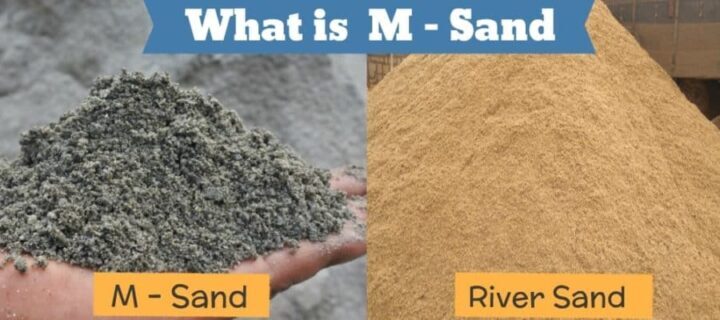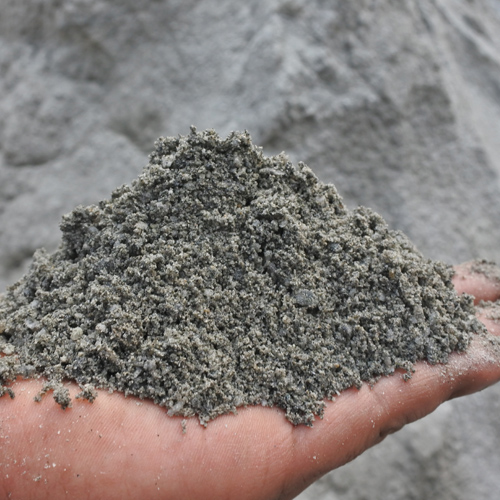
MANUFACTURED SAND – COMPARISON WITH RIVER SAND
What does M-Sand Mean?

M-Sand means Manufactured Sand. M- Sand is manufactured from a cubical shaped granite stone with grounded edges, washed and graded with consistency to be used as a substitute of river sand.
Definition: A fine aggregate that is produced by crushing stone, gravel, or slag.
Why Manufactured Sand:
We know that the river sand is mostly used for construction purpose all around the world, majorly for concrete making, cement mortar, and concrete blocks.
Various factors that show the need for manufacturing sand:
1) Global scarcity for natural sand:
Excessive sand exploration and out of limit consumption of natural aggregate sources have led to the implementation of new environmental/land use legislation. This law makes the supply of natural sand difficult and expensive. Nowadays sand mining is heavily taxed/ banned in many parts of the world.
2) Growing demand for fine-aggregates in construction:
it is nearly 30 – 35% volume of concrete is made up of fine aggregate. The UK construction industry demands an approximate 200 Million Tonnes of aggregates every year for various construction purposes.
3) The remote location of sandpits:
Due to legislative restriction on sand mining, the source of sand supply are now limited. Also there are available in remote location away from area of consumption Leeds to high cost of transportation.
4) Presence of silt and clay in natural sand:
Natural sand contains a high amount of impurities like silt and clay which can damage screed and concrete if the sand is not given proper treatment to bring down clay and other impurity content to acceptable levels.
Some of the Alternatives to River Sand:
- Manufactured Sand
- Fly Ash/ Bottom Ash/Pond Ash
- Copper Slag – Filtered Sand
- Sea Sand, Slag Sand
- Crushed Waste Glass
- Recycled Aggregate/C&D Waste Aggregate etc.
The demand for alternative materials of river sand for making concrete is increasing day by day as river sand cannot meet the rising demand of construction sector. It is fact that the river sand takes millions of years to form. Because of limited source of natural sand, the cost of River sand has skyrocketed and its consistent supply cannot be guaranteed. Under this condition the use of manufactured sand becomes inevitable.
Issues and General Requirements of Manufactured Sand:
The Civil engineers, Architects, Builders, and Contractors agree that the river sand, which is available today, is deficient in many respects. It does content very high silt fine particles (as in case of Filter sand). Sometimes the presence of other impurities like coal, bones, shells, mica and silt, etc makes m – sand unfit for the use in cement concrete and due to weathering effect, this material decay which results in shortens the life of the concrete. Nowadays, the government has implemented restriction on river sand exploration and uses. Sand Mining from river bed has deep impact on the environment, as water table goes deeper & ultimately dry.
General Requirements:
- M – Sand particles should have a higher crushing value.
- The surface texture of M – Sand particles should be smooth and even.
- The Particles should have a rounded shape.
- The Percentage of fines below 600 microns in the sand should not be less than 3.
- M – sand should not contain any organic impurities.
- Silt contain in M – Sand should not be more than 2%, for crushed sand.
- The number of fines below 75 microns shall not exceed 15% in M – Sand.
Comparison of M – Sand with River Sand:

Is Sieve | River Sand % Age Passing | M-Sand % Age Passing | % Age passing for single sized aggregates of Normal Sand 115 383 – 19701 Zone II |
4.75 mm | 99.25 | 99.75 | 90 to 100 |
2.36 mm | 93.50 | 78.25 | 75 to 100 |
1.18 mm | 48.00 | 52.00 | 55 to 90 |
600 Microns | 21.00 | 38.00 | 35 to 59 |
300 Microns | 4.00 | 21.00 | 08 to 30 |
150 Microns | 0.05 | 5.00 | 0 to 10 |
Comparison of Impurities – River Said Vs M-Sand | ||
| River Sand | M-Sand |
Marine Products. | 2 – 4 % | Nil |
Oversized Materials | 6 – 10% | Nil |
Clay & Silt | 5 – 20% | Nil |
Natural Sand | Manufactured Sand |
Excessive and illegal quarrying of Natural sand at river beds, resulting into soil erosion and danger to the reservoir structures | 100% replacement to Natural sand & It is One of the hi-product of aggregates |
Scarcity due to ban on quarrying activities near the river bed by the Govt. to prevent depleting of natural resource | No scarcity. as the Govt. is encouraging the business to garnerun-tapped revenue. |
No control on silt content | Govt. has identified the places and accorded the sanction for carrying out quarrying and crushing activities without compromising on any environmental issues |
Very long distance transportation resulting into volurne toss on the quantity of sand received at site | Sand washing machine to ensure 0% silt content, benefiting best economized concrete with possibilities of reduction in cement content |
Adulteration with filter sand (Unfit to be used in concrete] | Uninterrupted supply even during rainy season, which in turn facilitating timely completion of the project. |
No guarantee on gradation | No adulteration |
Huge inventory cost during monsoon for non avail- ability | World class Machine is employed to get the Top-Quality-Graded aggregates meeting both BIS and Customer requirement, the Consistency on the required gradation is guaranteed. |
Fear of not getting sand, if rejected for quality | No fear, the quality is the main focus. |
Additional manpower for removal of pebbles & boulders while Loading into belching plant to avoid pump choke ups | No additional manpower is required to remove boulders or pebbles, which is again cost saving |
No mechanism on pricing ethical | Transparency in pricing as the manufacturing facility is legal |
The Advantages of Manufactured Sand:
More cost-effective than natural sand: M – Sand manufacturing plant can be set up near the area of consumption, bringing down the cost of transportation and providing an assurance of consistent supply.
Compliant with the new European Standards: M – Sand can be used as aggregates in screed and concrete mixes, as per EN13139. As it can be utilized for blended mixture with natural sand.
Less disruptive to the environment: since the raw material for manufacturing m – sand is away from cities it is less environment effect. Also, use of sand can save natural river bed condition, which is essential for any river.
Lesser impurities and good working properties: It is free of silt and clay particles, and has denser particle packing than natural sand. M – sand has better test like higher flexural strength, better abrasion resistance, higher unit weight and lower permeability.
Disadvantages of Manufactured Sand:
Workability Issues: M – Sand is come up with coarse classification and angular texture than natural sand, which is smooth and rounded due to natural gradation. To overcome this we have add more amount of cement to achieve the expected workability, leading to increased costs.
Larger Proportion of Micro Fines: M – Sand contains large amount of fine particle, this is due its manufacturing process. Excessive fine can affect strength and workability of concrete.
Expert Opinion:
It is proven fact that the concrete manufactured with M – Sand perform better than concrete with natural sand as the property of crush sand is better than that of natural sand. M – Sand is environment friendly as it replace the natural sand. The cost of concrete made up with M – Sand is less than concrete made with natural sand. Also, Govt. has to encourage the use of M – Sand to save river natural bed strata.